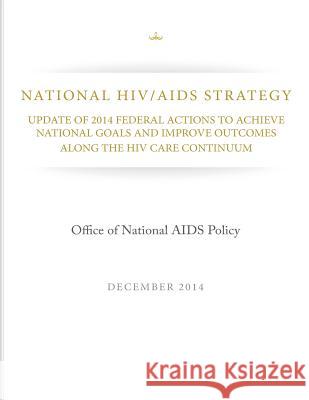National HIV/AIDS Strategy: Update of 2014 Federal Actions to Achieve National Goals and Improve Outcomes Along the HIV Care Continuum » książka
National HIV/AIDS Strategy: Update of 2014 Federal Actions to Achieve National Goals and Improve Outcomes Along the HIV Care Continuum
ISBN-13: 9781505346480 / Angielski / Miękka / 2014 / 32 str.
National HIV/AIDS Strategy: Update of 2014 Federal Actions to Achieve National Goals and Improve Outcomes Along the HIV Care Continuum
ISBN-13: 9781505346480 / Angielski / Miękka / 2014 / 32 str.
(netto: 56,43 VAT: 5%)
Najniższa cena z 30 dni: 55,53 zł
ok. 13-18 dni roboczych.
Darmowa dostawa!
Since President Obama released the nation's first comprehensive National HIV/AIDS Strategy in July 2010, a seismic shift in how the nation conducts HIV research, prevention, care, and treatment has occurred. Central to the Strategy is the unifying vision that "the United States will become a place where new HIV infections are rare and when they do occur, every person, regardless of age, gender, race/ethnicity, sexual orientation, gender identity or socio-economic circumstance, will have unfettered access to high quality, life-extending care, free from stigma and discrimination." Implementation of the Affordable Care Act, which has now extended health care coverage to millions of Americans, has a dynamic and evolving relationship with the Strategy that in coordination addresses the public health imperative to stop AIDS in the United States. In the nearly five years since passage of the Affordable Care Act and release of the National HIV/AIDS Strategy, the knowledge, tools and infrastructure at our disposal to prevent new infections and deliver care and services have changed dramatically (Figure 1). The Strategy's goals are to reduce new HIV infections, increase access to care and improve outcomes for people living with HIV, and reduce HIV-related health disparities. Last year, President Obama launched the HIV Care Continuum Initiative to further the goals of the National HIV/AIDS Strategy and galvanize the national response to HIV. The initiative directs Federal agencies to step up their efforts to improve outcomes by accelerating HIV diagnosis, linkage to and engagement in medical care, initiation of antiretroviral treatment, and sustainability of viral suppression. Federal agencies have responded to this call, and this report highlights some of the progress that has been made toward achieving HIV Care Continuum goals. These successes include introducing new population-specific awareness campaigns, developing innovative care delivery models, tackling stigma, discrimination, and other barriers to care, strengthening data collection and its use to improve outcomes and monitor resource deployment, prioritizing new health research, and building capacity to improve service-delivery, particularly at the state and local levels. Even with these advances, it remains clear that achieving our national goals requires further action: First, it requires enhancing our effectiveness in reaching those disproportionately impacted by the epidemic and improving their health outcomes. Data from Federal, state, and local sources suggest that less than a third of people with HIV achieve viral load suppression and accrue the full benefit of effective HIV medical care, which has the capacity not only to preserve health and extend life but also to reduce HIV transmission. In order to reduce the number of HIV infections in our country, we must focus and seize every opportunity to reduce geographic and demographic disparities in HIV care outcomes, especially among gay and bisexual men of all races and ethnicities, women and men of color, young people, transgender people, and persons living in southern states. Second, achieving our national goals requires sustained effort in every sector. Developing and maintaining effective partnerships among Federal, state, local, and tribal governments and private-sector partners is critical to accelerating our collective progress. This report highlights several successes in these areas including improved Federal collaboration, innovative demonstration projects that have ushered in new ways of working across agencies and sectors, listening sessions held in American communities, and meetings that have brought the voices of those working in the field to the White House, leading to exciting new public-private partnerships.











